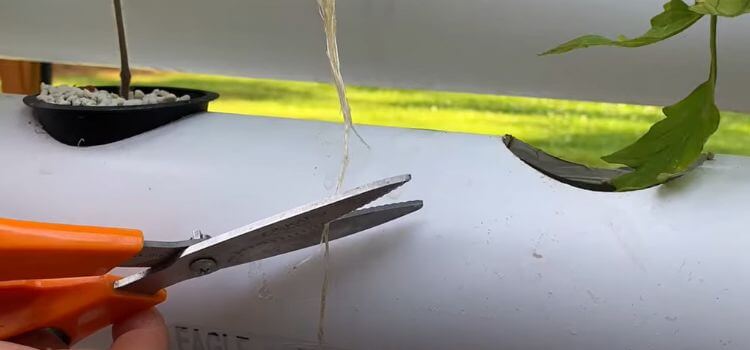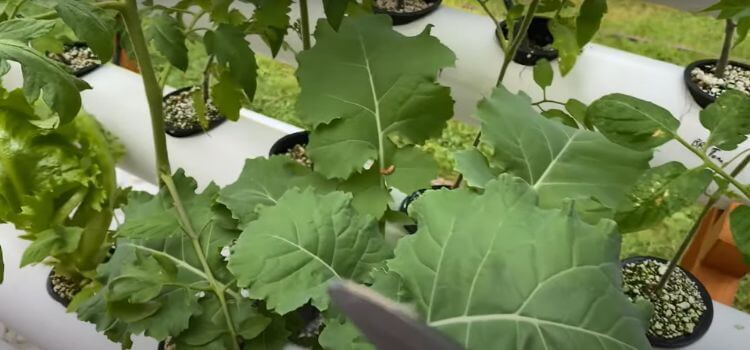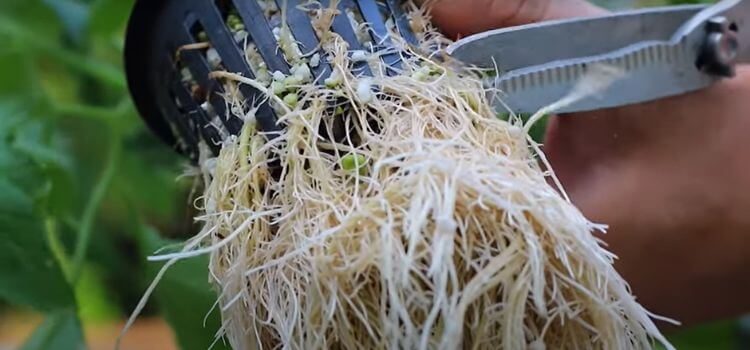As an Amazon Associate, I earn from qualifying purchases.
Yes, you can trim roots in hydroponics to maintain system efficiency and plant health. Pruning roots should be done carefully to avoid plant stress.
Hydroponic systems offer a unique method for growing plants in nutrient-rich solutions without soil. Root trimming in these systems becomes necessary to prevent clogging and ensure proper water and nutrient flow. It’s a practice embraced by seasoned hydroponic enthusiasts and commercial growers alike to keep their systems running smoothly and their plants thriving.
By managing root growth, growers can optimize the health of their hydroponic garden, leading to more robust and productive plants. This maintenance step is crucial for ensuring long-term success and high yields in any hydroponic setup.
How to trim roots in your Hydroponic
Keeping hydroponic roots healthy is key for plant growth. Root trimming is an essential part of hydroponic maintenance.
Air Pruning
Air pruning is a natural way to keep roots healthy. This method uses air to naturally trim back roots. It encourages a more fibrous root structure. Here’s how it works:
- Roots grow out to the air gap.
- The exposed roots dehydrate and naturally prune.
- New growth focuses on the inside, creating a dense root system.
This technique boosts oxygen absorption and nutrient uptake. Plants become more resilient and grow faster.
Sterile Blade Pruning
Sterile blade pruning involves cutting roots manually. It’s precise but requires care. Follow these steps for safe pruning:
- Choose a sharp, sterile blade to prevent infection.
- Cut away only the necessary root parts.
- Avoid cutting the main root structure.
Regular pruning can prevent overgrowth and ensure nutrients reach all parts of the plant. Healthy roots lead to more nutritious plants.

Benefits Of Root Trimming
Trimming the roots in hydroponics is like giving plants a new lease on life. Healthy roots mean healthy plants.
Improved Nutrient Uptake
Think of roots like straws in a juice box. When they’re clear, the juice flows freely. It’s the same with plants. Trimmed roots absorb water and nutrients better, resulting in lush, vibrant growth above the surface. Root trimming removes dead parts that can hinder growth. It ensures each root gets its share of the hydroponic solution, so the plant doesn’t waste energy on old, inefficient roots.
Prevention Of Root Rot
Roots love moisture, but too much can be a bad thing. Dense, overgrown roots can trap water and invite fungi. This can lead to root rot, a deadly issue in hydroponic systems. By trimming the roots, you increase airflow and reduce moisture buildup. This keeps the root zone healthy and rot-free. Regular trims are like check-ups for your plants, preventing issues before they start.
Remember, a clean cut is a happy cut. Use sharp, sterile tools for trimming to avoid damaging the roots.
Plants Suitable For Root Trimming
Are you curious about which plants thrive when their roots are trimmed in hydroponic systems? Some plants handle root trimming exceptionally well. This technique is vital for healthy growth and space management.
Fast-growing Plants
Fast-growing plants often need root trimming in hydroponics. Their rapid root development can crowd systems quickly. Here are some suitable fast-growers:
- Lettuce – It grows quickly and responds well to trimming.
- Basil – This herb can get bushy, so root maintenance helps.
- Tomatoes – Vigorous root systems need regular checks.
Plants With Overgrown Roots
Some plants may end up with overgrown roots, even without fast growth. Trimming can prevent issues. Good candidates include:
- Peppers – They can develop thick roots, which may need pruning.
- Cucumbers – Large root masses can form and benefit from cuts.
- Orchids – While not a typical choice, they can adapt to hydroponics with careful root care.
When To Trim Roots
Knowing when to trim roots in hydroponics is key for healthy plants. Trimming roots helps manage plant growth and ensures a strong system.
During Transplantation
Transplanting is a critical time for trimming roots. It’s when plants move to a new home. Think of it as setting up your plants for success. Trim the roots just before you transplant. This encourages new growth and prevents shock. It’s like giving your plants a fresh start in their new space.
Regular Maintenance Trimming
Regular maintenance trimming keeps your system clean and your plants happy. It’s like a routine check-up for your hydroponic garden. Aim to trim roots every few weeks. This stops them from clogging the system and helps with nutrient absorption. Healthy roots mean a thriving plant.
Here’s a quick guide for trimming roots:
- Inspect the root system regularly.
- Look for overgrown or dead roots.
- Use sterile scissors to avoid spreading diseases.
- Trim gently to prevent stress.
- Monitor your plants after trimming for any signs of stress.
Trimming roots in hydroponics ensures your plants stay healthy and grow well. Remember to cut with care during transplantation and perform regular maintenance. This ensures your hydroponic garden remains a vibrant, productive space.

Tools For Root Trimming
Keeping a hydroponic system healthy includes maintaining the roots. The right tools are essential.
Pruning Shears
Pruning shears are the go-to tool for trimming roots. They offer a clean cut and are easy to handle. When selecting shears, look for ones with stainless steel blades. This ensures durability and prevents rust. Make sure they fit comfortably in your hand for precise cutting.
- Comfortable grip: Prevents hand fatigue during use.
- Sharp blades: Offers clean cuts to avoid damaging roots.
- Stainless steel: Resists corrosion and ensures longevity.
Scalpel Or Razor Blade
For finer work, a scalpel or razor blade is ideal. These tools are perfect for delicate roots that require precision. A scalpel provides accuracy for intricate cuts. A razor blade can be used to slice through thin roots quickly.
| Tool | Use Case | Benefits |
|---|---|---|
| Scalpel | Delicate, precise cuts | Accuracy, control |
| Razor Blade | Quick, thin cuts | Speed, efficiency |
Remember, sharp tools not only make the job easier but also promote healthy root growth. Dull blades can crush or tear roots, leading to potential plant health issues.
Precautions To Take
Precautions to Take are vital when considering trimming the roots in your hydroponic system. Root maintenance is key to a healthy plant, but it’s a delicate process. Ensure you understand the right techniques and times to trim. This will prevent damage and stress to your plants.
Avoiding Over-trimming
Avoiding over-trimming is crucial. Plants rely on their roots for nutrition and stability. Too much trimming can harm your plants. Follow these guidelines:
- Assess root length and health.
- Trim only what’s necessary.
- Monitor plant response after trimming.
Remember, less is more. Trim gradually. Keep a close eye on your plants to see how they cope.

FAQ On Can You Trim Roots in Hydroponics?
To prune hydroponic roots:
Gently remove your plant from the system.
Trim back any dead or overgrown roots with sterilized scissors.
Pruning only a third of the root mass at one time ensures minimal stress to the plant.
Return the plant to the system promptly.
To control roots in hydroponics, regularly trim root mass, ensure proper spacing, maintain clean systems, use appropriate water temperatures, and monitor nutrient levels.
Yes, trimming plant roots is acceptable for promoting healthy growth and managing size, but it must be done carefully to avoid harm. Always use sterile tools and trim during the plant’s dormant phase for best results.
Yes, you can trim Aerogarden roots. Gently cut excess growth without damaging the main root system to maintain plant health and ensure proper water flow.
Conclusion
Trimming roots in hydroponic systems is a viable practice. It promotes healthy plant growth and prevents potential system clogs. Just remember, gentle care is crucial to avoid stressing your plants. With proper technique and timing, root trimming can greatly enhance your hydroponic garden’s vitality and productivity.
Happy gardening!

